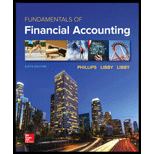
1.
To Compute: The present value of the note, rounded to the nearest dollar, using a typical interest rate of 6%.
1.
Answer to Problem 3CP
The present value of the note, rounded to the nearest dollar, using a typical interest rate of 6%, is $26,730.
Explanation of Solution
Present value is the amount of future value reduced or discounted at a rate of interest till particular current date.
Formula to compute present value of single payment with tables:
Compute the present value of the note, rounded to the nearest dollar, using a typical interest rate of 6%.
2.
To Journalize: An entry to record the purchase of the equipment, rounded to the nearest dollar.
2.
Answer to Problem 3CP
The
| Date | Account Title | Debit ($) | Credit ($) |
| Equipment | $26,730 | ||
| Notes payable | $26,730 | ||
| (To record the purchase of equipment) |
Table (1)
Explanation of Solution
Journal entry: Journal entry is a set of economic events which can be measured in monetary terms. These are recorded chronologically and systematically.
Debit and credit rules:
- Debit an increase in asset account, increase in expense account, decrease in liability account, and decrease in
stockholders’ equity accounts. - Credit decrease in asset account, increase in revenue account, increase in liability account, and increase in stockholders’ equity accounts.
3.
To Journalize: An
3.
Answer to Problem 3CP
The adjusting entry to record first payment at the end of the first year is shown below.
| Date | Account Title | Debit ($) | Credit ($) |
| Interest Expense(1) | $1,604 | ||
| Notes payable(2) | $8,396 | ||
| Cash | $10,000 | ||
| (To record the first payment) |
Table (2)
Explanation of Solution
Journal entry: Journal entry is a set of economic events which can be measured in monetary terms. These are recorded chronologically and systematically.
Debit and credit rules:
- Debit an increase in asset account, increase in expense account, decrease in liability account, and decrease in stockholders’ equity accounts.
- Credit decrease in asset account, increase in revenue account, increase in liability account, and increase in stockholders’ equity accounts.
Working Notes:
Calculate the interest on the notes payable:
Calculate the amount paid on the notes payable:
4.
To Journalize: An adjusting entry to record the second payment at the end of the second year.
4.
Answer to Problem 3CP
The adjusting entry to record the second payment at the end of the second year is shown below.
| Date | Account Title | Debit ($) | Credit ($) |
| Interest Expense(3) | $1,100 | ||
| Notes payable(4) | $8,900 | ||
| Cash | $10,000 | ||
| (To record the second payment) |
Table (3)
Explanation of Solution
Journal entry: Journal entry is a set of economic events which can be measured in monetary terms. These are recorded chronologically and systematically.
Debit and credit rules:
- Debit an increase in asset account, increase in expense account, decrease in liability account, and decrease in stockholders’ equity accounts.
- Credit decrease in asset account, increase in revenue account, increase in liability account, and increase in stockholders’ equity accounts.
Working Notes:
Calculate the interest on the notes payable:
Calculate the amount paid on the notes payable:
5.
To Journalize: An entry to record the payment for the equipment, rounded to the nearest dollar.
5.
Answer to Problem 3CP
The journal entry to record the payment for equipment is shown below.
| Date | Account Title | Debit ($) | Credit ($) |
| Interest Expense(5) | $566 | ||
| Notes payable(6) | $9,434 | ||
| Cash | $10,000 | ||
| (To record the third payment) |
Table (4)
Explanation of Solution
Journal entry: Journal entry is a set of economic events which can be measured in monetary terms. These are recorded chronologically and systematically.
Debit and credit rules:
- Debit an increase in asset account, increase in expense account, decrease in liability account, and decrease in stockholders’ equity accounts.
- Credit decrease in asset account, increase in revenue account, increase in liability account, and increase in stockholders’ equity accounts.
Working Notes:
Calculate the interest on the notes payable:
Calculate the amount paid on the notes payable:
Want to see more full solutions like this?
Chapter C Solutions
Fundamentals Of Financial Accounting
 EBK CONTEMPORARY FINANCIAL MANAGEMENTFinanceISBN:9781337514835Author:MOYERPublisher:CENGAGE LEARNING - CONSIGNMENT
EBK CONTEMPORARY FINANCIAL MANAGEMENTFinanceISBN:9781337514835Author:MOYERPublisher:CENGAGE LEARNING - CONSIGNMENT Cornerstones of Financial AccountingAccountingISBN:9781337690881Author:Jay Rich, Jeff JonesPublisher:Cengage Learning
Cornerstones of Financial AccountingAccountingISBN:9781337690881Author:Jay Rich, Jeff JonesPublisher:Cengage Learning Intermediate Accounting: Reporting And AnalysisAccountingISBN:9781337788281Author:James M. Wahlen, Jefferson P. Jones, Donald PagachPublisher:Cengage Learning
Intermediate Accounting: Reporting And AnalysisAccountingISBN:9781337788281Author:James M. Wahlen, Jefferson P. Jones, Donald PagachPublisher:Cengage Learning Intermediate Financial Management (MindTap Course...FinanceISBN:9781337395083Author:Eugene F. Brigham, Phillip R. DavesPublisher:Cengage LearningPrinciples of Accounting Volume 1AccountingISBN:9781947172685Author:OpenStaxPublisher:OpenStax College
Intermediate Financial Management (MindTap Course...FinanceISBN:9781337395083Author:Eugene F. Brigham, Phillip R. DavesPublisher:Cengage LearningPrinciples of Accounting Volume 1AccountingISBN:9781947172685Author:OpenStaxPublisher:OpenStax College





